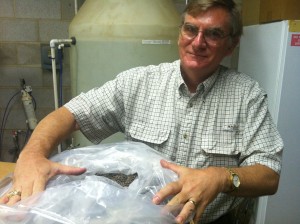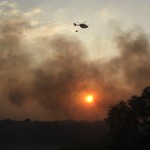Wildfires Underscore the Need for Seed

Photo by Mose Buchele
State officials, conservationists, and representatives from donor groups marked the start of a tree replanting campaign by watering seedlings in Bastrop State Park.
Well-wishers and reporters sweated under the late summer sun recently in Bastrop State Park, as officials announced the start of a tree planting campaign for a forest that was 95 percent destroyed by fire last year.
Texas Parks and Wildlife hopes to raise millions of dollars to fund a vast tree replanting effort. For many, that campaign marks a new beginning in the life of the park.
“You know the good thing about today and what this kind of symbolizes is that we’re through looking back. We’re looking forward. And that’s what planting a pine seedling is all about,” Texas Forest Service Director Tom Boggus told the crowd.
But as the speakers gathered for a photo-op to water the seedlings, the past wasn’t really that far behind. The fact that the seedlings were there at all came down to a very close call about a year ago, when the Forest Service had almost thrown away all the seeds that are now so essential to the park’s recovery.
“We had had them, since 1992 in a freezer, you know and we thought ‘OK, are we ever going to use them? Maybe not,'” Boggus explained to StateImpact Texas. “Thank God we didn’t [throw them out]. That’s 1,000 pounds of seed and we had 98 percent germination.”
The seeds were being stored, free of charge, in a pharmacy freezer. Tom Byram, Director of the Western Gulf Forest Tree Improvement Program with the Texas Forest Service, says he was three weeks away from assembling a crew and disposing of the seed when the fire struck.
The seeds had been left over over from when the Forest Service maintained its own commercial tree nursery. That closed in 2008 when the state decided that the private sector was doing a fine job growing trees. But commercial growers only want to grow trees that are profitable.
“Basically, you’ve got a divergence in the interests of the people involved. Because you’ve got the people that are the commercial people and they want to run a breeding program to do the fastest growth and that kind of thing,” says Byram.
What that means is that native seeds for trees like the Loblolly Pines that make up the Lost Pines forest are hard to come by. And the fires have promoted calls for the state to take a more active roll in protecting that resource.
Another Close Call
Last year, around the same time the forest service was planning to dispose of the pine seeds, graduate student Vlad Codrea received a grant from UT to start his own Loblolly pine nursery. With cash at the ready, he began looking for commercial seed vendors who could fill his order. There were none.
“I found it kind of frustrating that we couldn’t buy these seeds, even if we wanted to pay a fair market price for them,” Codrea recalled.
He ended up getting his seeds from the Forest Service’s supply, for free, just three days before the wildfires hit. Now, he says he would like to see greater efforts made to protect seed supplies.
“Storing as many of those seeds as possible for natural disaster such as this is in everybody’s best interest,” says Kodrea.
And it’s not just the Loblolly pine trees that are unavailable on the open market.
“Where do you get new post oaks?” asks April Rose, director of the tree planting group Treefolk. “There is a void for that right now and those trees are really well adapted to our climate. You know that’s an example of a species that adds a lot of value to our ecosystem and it is not commercially available and it would be a great candidate for seed banking.”
A Question of Funding
The fires have prompted some changes in how the Forest Service handles its seed supply. For one thing, Forest Service Director Boggus says the agency is going to hold on to its remaining supply of Loblolly Pine seeds.

Photo by Mose Buchele
Even after years in a freezer, these seeds attained a 95 percent germination rate, and will be used to replant Bastrop State park.
“Not only that, we’ve refurbished our seed orchard and we’re collecting new seed off of that, because now we know. You just never know when you’re going to need it,” Boggus told StateImpact Texas.
But when it comes to larger efforts to protect native species, the agency runs up against a familiar obstacle: money.
“The seed banking, maintaining the natural variation — that kind of thing is really something a public agency should be doing,” Byram told StateImpact Texas. “We don’t really have the funds to do that kind of thing so it’s really a problem on how you balance that out.”
And with Texas agencies asked to find cuts equaling ten percent of their budgets in the upcoming legislative session, funding will likely continue to be a problem for seed storage, and a many other projects, into the future.


